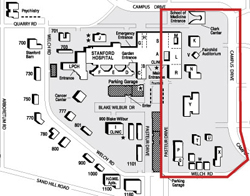August 21, 2007 - By Ruthann Richter
School of Medicine extends smoking ban to outdoor zones

The School of Medicine "tobacco-free" zone covers the area bounded by Welch Road, Pasteur Drive and Campus Drive West.
As of Sept. 1, the School of Medicine will be declared a tobacco-free zone, with no smoking allowed anywhere on its campus.
The ban is part of a growing movement nationwide to limit smoking, which is the leading preventable cause of death in the United States. The new policy extends the medical school's indoor ban on tobacco to the outdoors, including the patios and seating areas around the Clark Center. The move is aimed at promoting healthy lifestyles among faculty, staff and students while sending a strong message against tobacco use to the broader community.
'It is my hope that this expansion of our official smoking policy will signal to the tobacco industry our nearly universal abhorrence of its practices and our commitment to promoting the health of our community,' said Philip Pizzo, MD, dean of the School of Medicine.
The policy is more stringent than the university's guidelines, which permit smoking outdoors beyond 20 feet from buildings, except during organized events. The new policy does not apply to Stanford Hospital & Clinics and Lucile Packard Children's Hospital, which will continue to allow smoking in designated areas outside.
The ban applies to the area bounded by Welch Road, Pasteur Drive and Campus Drive West.
With the new policy, the medical school joins a few other academic medical centers, including the University of Rochester Medical Center, that have implemented a total ban on smoking in and around their campuses.
Every year, an estimated 438,000 Americans die from the ravages of cigarette smoking, including 38,000 people who die as a result of exposure to secondhand smoke, according to the federal Centers for Disease Control and Prevention.
While the hazards of exposure to secondhand smoke indoors have been well-documented, it's only recently that researchers have begun to measure the impact of smoking outdoors. In one study published in May, a team of Stanford researchers found that non-smokers sitting in outdoor cafes, parks and other gathering places could be exposed to significant levels of toxins from smokers puffing nearby.
'A lot of people might assume that the smoke is very dilute and just floats away immediately. But if you are downwind of one or two smokers while sitting at a table or bench, you could be exposed as much as if you were in a smoky bar,' said Neil Klepeis, PhD, assistant professor (consulting) of civil and environmental engineering and lead author of the study. The study was published in the Journal of the Air and Waste Management Association.
Even brief exposures to this kind of secondhand smoke can have immediate adverse effects on the heart and respiratory system and can increase the frequency of asthma attacks, especially in children, according to a 2006 report from the U.S. Surgeon General.
Given myriad health problems associated with smoking, Robert Jackler, MD, professor and chair of otolaryngology, said he believes it's important for the school to promote a non-smoking culture and send the message, particularly to young people, that tobacco use is unacceptable.
'I am chagrined when children and young adults witness medical personnel smoking. The message received is that if they smoke, with what they know, it must really not be so bad for you,' said Jackler, who currently has an exhibit at the medical school's Lane Library on deceptive tobacco company advertising.
Jackler said he recognizes there are issues of personal freedom and choice when it comes to regulating smoking.
'People still have the choice to smoke, but making it inconvenient to light up often helps those who wish to stop to achieve their desired goal,' he said. Surveys show most smokers wish they could quit, he noted.
The designers of the policy say they hope it will entice faculty, staff and students who smoke to give up the habit. Data collected over the last two years from the Stanford Health and Lifestyle Assessment indicated that 4 percent of 1,088 employees surveyed smoked, said Wes Alles, PhD, director of the Health Improvement Program. That's about half the rate in the Bay Area and well below national figures, Alles said.
The university is also offering a new benefit starting Sept. 1 to help employees and their family members quit tobacco.
For more information on the medical school's new smoking policy, visit the School of Medicine's Web site: http://med.stanford.edu/tobaccofree.
About Stanford Medicine
Stanford Medicine is an integrated academic health system comprising the Stanford School of Medicine and adult and pediatric health care delivery systems. Together, they harness the full potential of biomedicine through collaborative research, education and clinical care for patients. For more information, please visit med.stanford.edu.